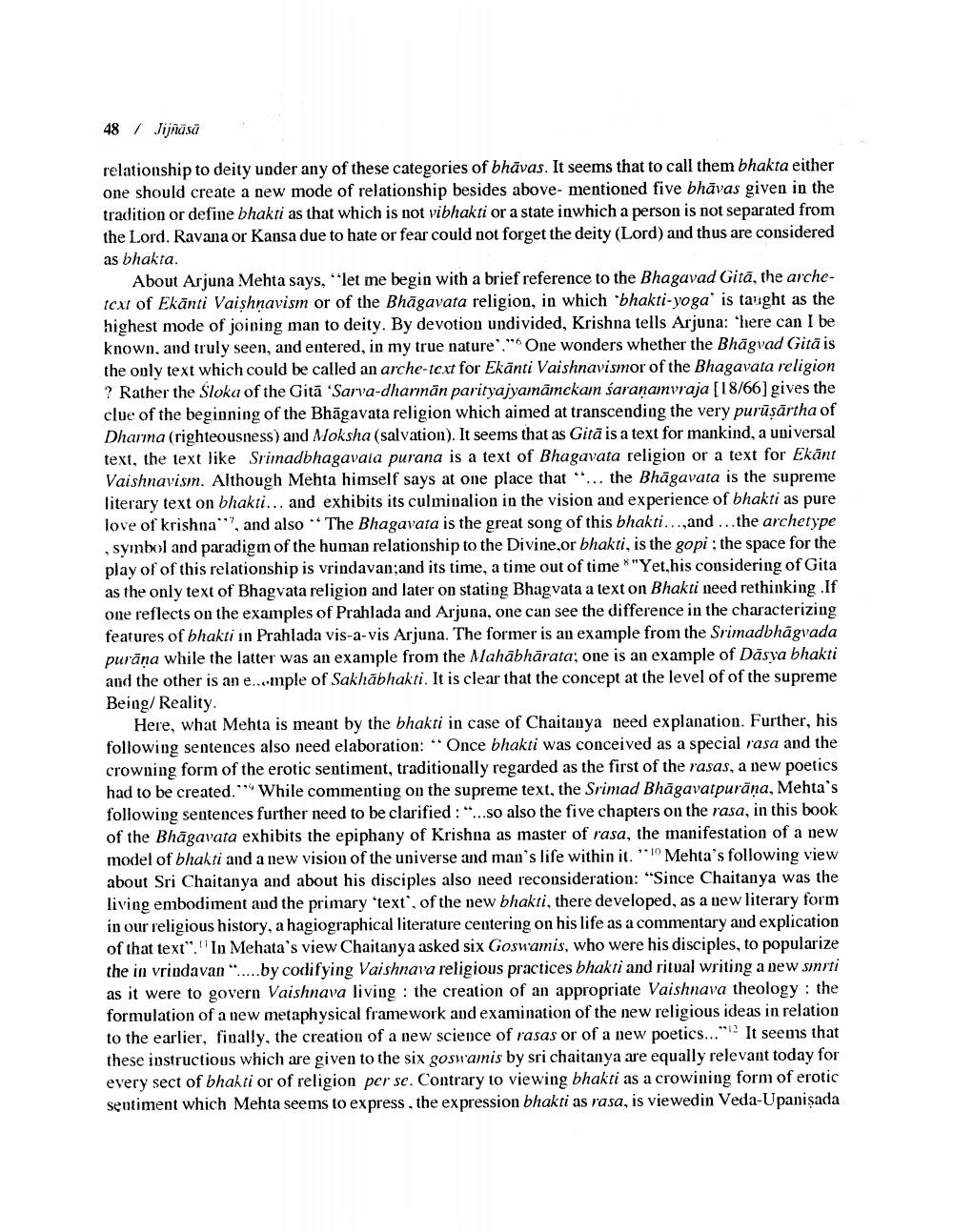________________
48
/
Jijnäsä
relationship to deity under any of these categories of bhāvas. It seems that to call them bhakta either one should create a new mode of relationship besides above-mentioned five bhāvas given in the tradition or define bhakti as that which is not vibhakti or a state inwhich a person is not separated from the Lord. Ravana or Kansa due to hate or fear could not forget the deity (Lord) and thus are considered as bhakta.
About Arjuna Mehta says, let me begin with a brief reference to the Bhagavad Gitā, the archetext of Ekānti Vaishnavism or of the Bhāgavata religion, in which bhakti-yoga' is taught as the highest mode of joining man to deity. By devotion undivided, Krishna tells Arjuna: 'here can I be known, and truly seen, and entered, in my true nature'. One wonders whether the Bhāgvad Gitā is the oply text which could be called an arche-text for Ekānti Vaishnavismor of the Bhagavata religion ? Rather the Šloka of the Gitā "Sarva-dharmān parityajyamāmckan saranamvraja [18/66) gives the clue of the beginning of the Bhāgavata religion which aimed at transcending the very purūṣārtha of Dharma (righteousness) and Moksha (salvation). It seems that as Gitā is a text for mankind, a universal text, the text like Srimadbhagavaia purana is a text of Bhagavata religion or a text for Ekānt Vaishnavism. Although Mehta himself says at one place that ... the Bhāgavata is the supreme literary text on bhakti... and exhibits its culminalion in the vision and experience of bhakti as pure love of krishna", and also * The Bhagavata is the great song of this bhakti...,and ... the archetype , symbol and paradigm of the human relationship to the Divine.or bhakti, is the gopi : the space for the play of of this relationship is vrindavan; and its time, a time out of time * "Yet,his considering of Gita as the only text of Bhagvata religion and later on stating Bhagvata a text on Bhakti need rethinking. If one reflects on the examples of Prahlada and Arjuna, one can see the difference in the characterizing features of bhakti in Prahlada vis-a-vis Arjuna. The former is an example from the Srimadbhāgvada purāṇa while the latter was an example from the Mahābhārata; one is an example of Dasya bhakti and the other is an e...-mple of Sakhābhakti. It is clear that the concept at the level of of the supreme Being/ Reality.
Here, what Mehta is meant by the bhakti in case of Chaitanya need explanation. Further, his following sentences also need elaboration: "Once bhakti was conceived as a special rasa and the crowning form of the erotic sentiment, traditionally regarded as the first of the rasas, a new poetics had to be created." While commenting on the supreme text, the Srimad Bhāgavatpurāna, Mehta's following sentences further need to be clarified: "...so also the five chapters on the rasa, in this book of the Bhāgavata exhibits the epiphany of Krishna as master of rasa, the manifestation of a new model of bhakti and a new vision of the universe and man's life within it." Mehta's following view about Sri Chaitanya and about his disciples also need reconsideration: "Since Chaitanya was the living embodiment and the primary 'text', of the new bhakti, there developed, as a new literary form in our religious history, a hagiographical literature centering on his life as a commentary and explication of that text". "In Mehata's view Chaitanya asked six Goswamis, who were his disciples, to popularize the in vrindavan".....by codifying Vaishnava religious practices bhakti and ritual writing a new smrti as it were to govern Vaishnava living : the creation of an appropriate Vaishnava theology : the formulation of a new metaphysical framework and examination of the new religious ideas in relation to the earlier, finally, the creation of a new science of rasas or of a new poetics... It seems that these instructions which are given to the six goswamis by sri chaitanya are equally relevant today for every sect of bhakti or of religion per se. Contrary to viewing bhakti as a crowining form of erotic sentiment which Mehta seems to express, the expression bhakti as rasa, is viewedin Veda-Upanişada




